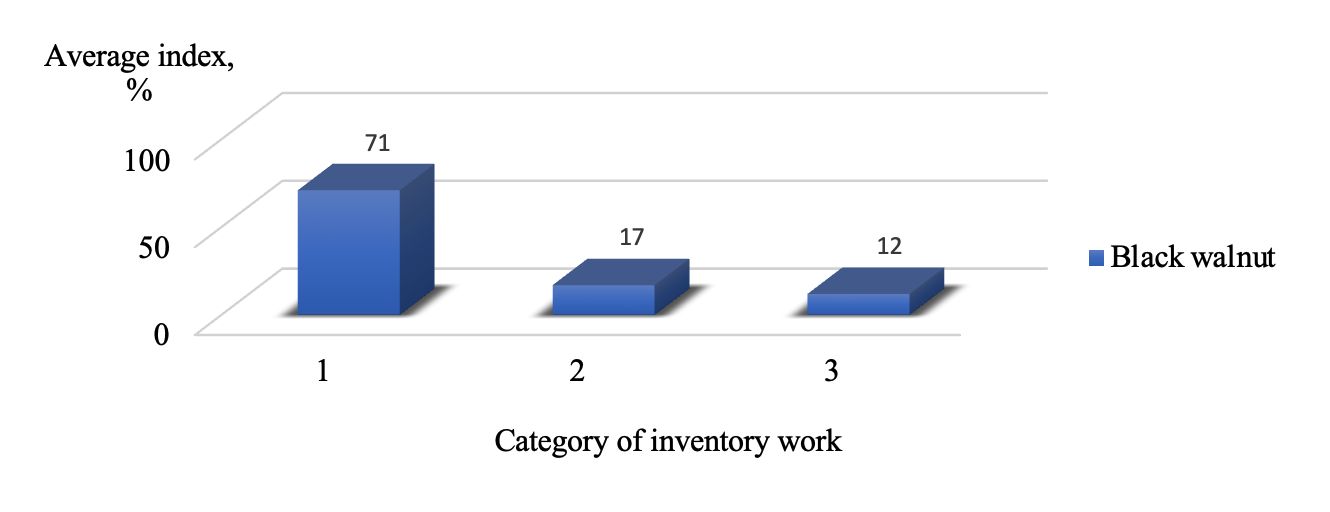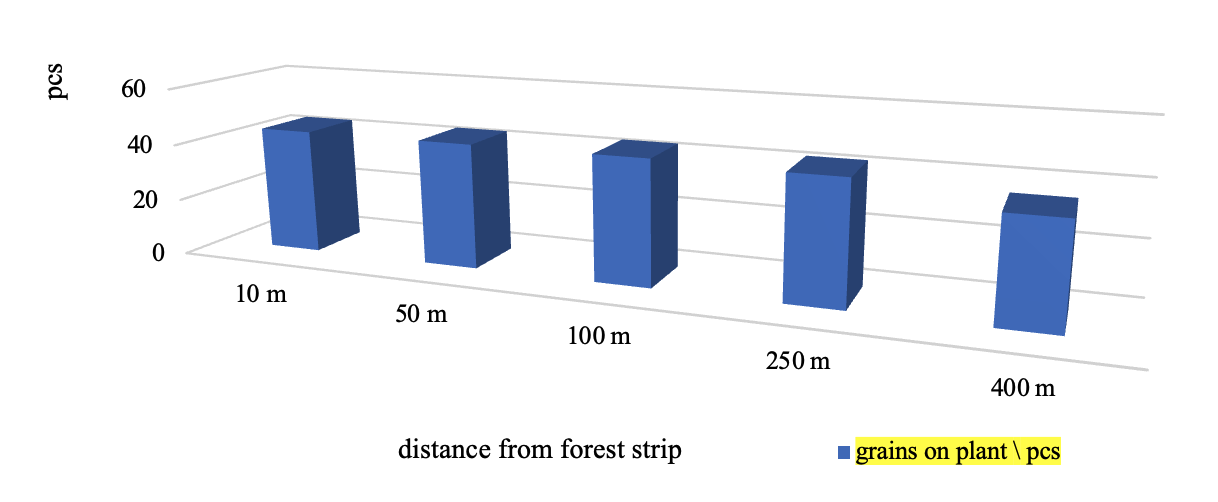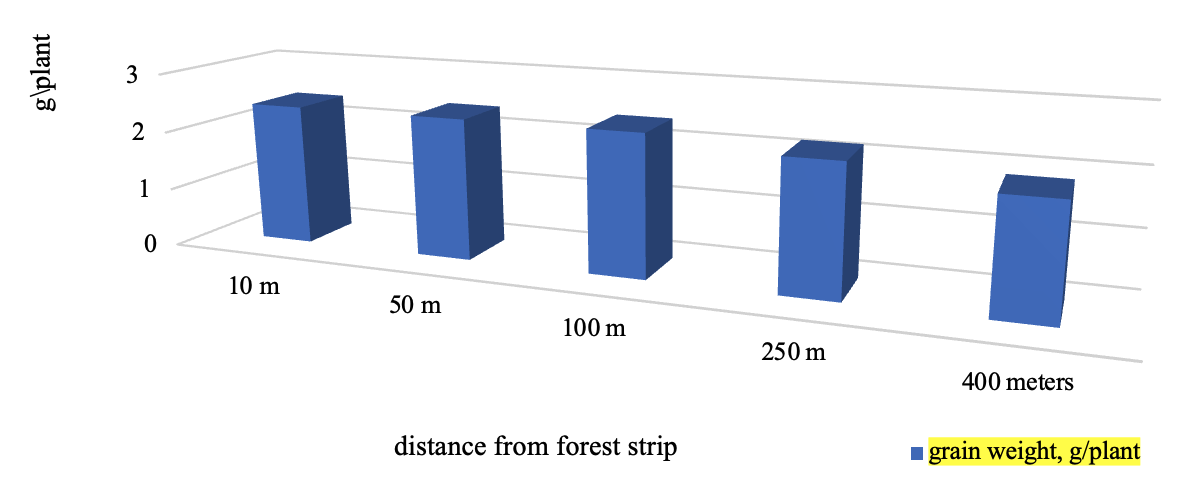СОСТОЯНИЕ ЗАЩИТНЫХ ЛЕСНЫХ НАСАЖДЕНИЙ И ИХ ВЛИЯНИЕ НА УРОЖАЙ И КАЧЕСТВО ЗЕРНА ОЗИМОЙ ПШЕНИЦЫ СОРТ ЭММА
СОСТОЯНИЕ ЗАЩИТНЫХ ЛЕСНЫХ НАСАЖДЕНИЙ И ИХ ВЛИЯНИЕ НА УРОЖАЙ И КАЧЕСТВО ЗЕРНА ОЗИМОЙ ПШЕНИЦЫ СОРТ ЭММА
Аннотация
В результате многолетних наблюдений было установлено, что наибольший эффект по благотворному влиянию защитных лесных насаждений на прилегающие поля происходит в том случае, когда создана полноценная система и находится она в оптимальном состоянии. Лесные полосы должны перекрывать защитные действия друг друга. Только в этом случае будет достигнут желаемый эффект защиты и благотворного влияния. Система полезащитных лесных насаждений (лесных полос) позволяет снизить влияние экстремальных природно-климатических факторов на агробиоценоз, являясь механическим препятствием на пути водных и ветровых потоков. В Краснодарском крае важно защитить поля в марте, когда чаще всего бывают пыльные бури и в июне — в период налива зерна. При экологическом обследовании агроэкосистем важно оценить правильность заложения системы лесных полос в составе севооборота. Система лесных полос проектируется с учетом агролесомелиоративной зоны, в которой находится объект исследования, направления вредоносных ветров и рельефа местности. После создания защитных лесных насаждений требуется выполнение работ по уходу за ними, так как это искусственно созданные лесные насаждения. Для уточнения требуемых в лесных полосах работ обязателен мониторинг и только на основе полученных результатов возможно принять оптимальный план. В результате выполненных исследований было установлено, что орех черный находится в хорошем состоянии и оптимально выполняет возложенную на него функцию главной породы в изучаемой лесной полосе № 1. Изученная лесная полоса при определении типа конструкции отнесена к ажурной (№ 1). Защитные лесные насаждения смогут выполнять возложенные на них задачи при проведении за ними ухода. Для лесной полосы под номером 2 определен тип конструкции, как не продуваемая. Лесная полоса № 2 не сможет выполнять возложенную на нее функцию, она требует проведения рубок ухода.
1. Introduction
For the agricultural regions of Russia, one of the most important problems that has become increasingly relevant over the years is the protection of agricultural fields from erosion processes, both wind and water. In the Krasnodar Territory, it is also of paramount importance, as the condition of protective plantings is gradually deteriorating, and in some areas, there are simply no forest strips. The beneficial effects of forest belts, in addition to protecting agricultural fields from erosion processes, are well known. They regulate snow distribution, contribute to the formation of a more powerful snow cover, create conditions for better accumulation of moisture in the soil and more productive use of it, reduce the wind force in the interstitial spaces.
"Forest belts reduce fluctuations in daily temperature in the fields, contribute to an increase in the relative humidity of the surface air layer by 3–5 %. A decrease in evaporation of water from the soil surface, as well as in transpiration, was present in the interband spaces. Planted forests protect winter crops from freezing, as the earth freezes to a lesser depth in protected fields. Forest strips have a positive effect on the effectiveness of a number of agricultural techniques. For example, fertilizers in protected fields produce higher grain yields than in unprotected fields" ,
, , , .Nevertheless, due to the aging of the forest strips created many decades ago, as well as the lack of proper care for them, especially in the last 30 years, most of them have become unsatisfactory. Currently, there is a renewed danger of wind erosion of soils (dust storms) in the Kuban. In addition, as indicated by soil scientists in the Krasnodar Territory, there is a gradual decrease in the optimal soil condition. This fact also contributes to the development of wind erosion of soils.
In the Kuban, wind erosion affects to one degree or another about 37% of all land and almost one third of arable land. This type of erosion is common in most areas of the region. The inability of farms to obtain high yields from such fields reduces the economic stability of farms, regions and the country as a whole.
The purpose of the research is to determine the biological state of tree species in forest belts and their effect on the harvest of winter wheat.
That requires to determine the biological state of tree species in the studied forest belts, to investigate the range of beneficial effects of protective forest belts on the winter wheat harvest, depending on the type of construction of forest plantations.
2. Research methods and principles
To determine the biometric parameters of tree species in each studied protective forest strip, 3 test sites were laid: 100 m long, 10 m wide (taking into account the edges). The soil is leached chernozem
, .The age was determined from archival materials and annual rings of woody plants; the height and circumference of tree trunks, and the structure of plantings were determined by the number of gaps in the vertical profile of the tree stand.
Experimental plots in a field of winter wheat were laid at a distance from the forest strip on the windward side — 10, 50, 100, 250, 400 m, on the windward side — 10, 50, 100, 150 m. The area of the plots is 25 m2, the repeatability is 4 times. The experimental data were processed by methods of variance analysis
.3. Main results
The rapidly increasing danger of further development of erosion processes, the transition to a market economy and the emergence of competition necessitate more efficient use of eroded and erosion-prone lands, while strictly complying with soil protection regulations and standards, and this requires an ecological, adaptive approach to the development and implementation of measures aimed at increasing the erosion resistance of landscapes and increasing agricultural productivity.
In the Krasnodar Territory, protective forest plantations were created, as a rule, both from two, three tree species, and from one. The wood composition was selected from the existing one in the territory of Kuban. Their resistance to pests and diseases and biological characteristics were studied. There were also no recommendations on the type of construction of forest strips. However, they appeared, and more accurately after 1969. Mainly recommended on the area of the Krasnodar Territory are forest strips of the type of blown, openwork or openwork-blown.
The blown forest strips are characterized by closed crowns of trees in the upper part of the plantation and large gaps between the trunks in the surface area. Openwork forest belts are a continuous wall of low shrubs in the ground zone with large gaps between the trunks of trees (starting from the top of the shrubs to the crowns of trees), as well as some gaps in the crowns of the trees themselves. Openwork-blown forest belts are devoid of shrubs, have large gaps in the lower part between the trunks of trees and small gaps in their crowns
, .To determine the biological state of the tree species in the main forest belt under study, inventory work was carried out in the study area (fig. 1).

Figure 1 - Average indicator of the main tree species category in forest zone No. 1
Note: average for 2023-2024
As a result of the work carried out on the inventory of forest strip No. 1, it was found that black walnut mainly (71%) belongs to the 1st category, 17% to the second and 12% to the third. The forest strip, in which the black walnut occupies 4 rows, is in good condition and can continue to do the "work" of having a beneficial effect on agricultural fields. The type of construction for this forest strip is openwork.
It is known that forest strips contribute to increasing the yield of agricultural plants.
"The combined beneficial effect of protective forest belts leads to increased crop yields. In the zone of effective beneficial influence of forest belts, grain yields are 20–30% higher, vegetable crops by 50–70 % and sown grasses by 100–200%. The influence of forest belts is especially beneficial in dry years, when grain increases reach 50% or more" .
However, these data for the Kuban conditions are somewhat outdated, as they were obtained back in the 80s of the last century. During this period, there have been changes in the temperature regime and soil conditions, new varieties of agricultural plants have appeared, and the state of protective forest belts has changed.
To study the possible beneficial effects of forest strips of various designs, the winter wheat variety Emma was sown. It was determined not only the beneficial effect of the created forest strips on the harvest of winter wheat, but also the range of this effect. The beneficial effect is determined primarily by the increase in yield per hectare.
As a result of a field experiment, completed in 2023-2024, performed on the territory of the 1st department of the Kuban Educational Institution of the Federal State Budgetary Educational Institution of Higher Education "I. T. Trubilin Kuban State Agrarian University", experimental data were obtained, which are shown in figure 2.

Figure 2 - The length of the ear of winter wheat variety Emma
Note: average for 2023-2024

Figure 3 - The number of grains per plant of winter wheat variety Emma
Note: average for 2023-2024

Figure 4 - Grain weight on a winter wheat variety Emma
Note: average for 2023-2024
The range of effective beneficial effects of a forest belt is determined by approximately thirty to five times its height (35 h). However, the positive impact of the forest belt is calculated in both directions from it: in the windward direction 5–15 h (average 10 h) and in the windward direction 20–30 h (average 25 h).
The studies carried out in the field conditions of the agricultural farm department 1 “Kuban” allowed us to determine the beneficial effect of the studied forest strip, which amounted to 250–300 m. However, it continues up to a distance of 400 m, since the length of the ear is 9 cm, which is generally included in the characteristics of the studied variety of winter wheat.
The physical properties of grains and seeds are of great importance for their storage and processing. These properties underlie the methods of quality determination, methods of movement, purification and processing of grain and seeds. The physical properties of grain and seeds include: grain shape, linear dimensions and coarseness, volume, completeness and thinness, alignment, weight of 1000 grains, glassiness, density, filminess and huskiness, bulk, mechanical damage to grain, fracturing, mechanical properties, aerodynamic properties, pest infestation, clogging.
For the studied winter wheat variety, some of the most important physical properties of the grain were determined in the laboratory, which are shown in table 1.
Table 1 - Physical properties of winter wheat grain variety Emma under the influence of an openwork forest strip, the windswept side
Type | Nature, g/l | Glassiness, % | Gluten, % | Gluten Strain Index |
1 (10m) | 754,63 | 78,2 | 25,0 | 75,0 |
2 (50m) | 761,12 | 75,6 | 25,2 | 75,0 |
3 (100m) | 750,36 | 74,6 | 24,8 | 72,5 |
4 (250m) | 748,58 | 73,4 | 23,6 | 72,5 |
НСР05 | 26,24 | - | - | - |
Note: average for 2023-2024
As the table data show, at a distance of 10 and 50 m from the protective forest strip, the grain quality of winter wheat is significantly higher than that at a distance of 250 m. The maximum absolute values of the studied grain quality indicators were noted at a distance of 50 m (in–kind — 761,12 g/l, in the control — 748,8 g/l; weight of 1000 seeds — 41,25 and 38,95 g; glassiness — 75,6 and 73,4%; gluten content — 25,2 and 23,6%; GSI — 75,0 and 72,5, respectively).
The following factors largely depend on the grain glassiness: the mode and scheme of grinding, the extraction of grains and their quality, the ease of sieving through sieves, the degree of moisture and the time of cooling after soaking during conditioning. The glassy grain of wheat usually contains a large amount of protein substances. The glassy grain yields a higher yield of flour than the powdery grain. Glassy grain flour is coarse-grained, which is highly appreciated in baking.
In the milling industry, the following classification of wheat by glassiness has been adopted: less than 40% is low–glassy (group I), from 40% to 60% is medium–glassy (group II), and over 60% is high–glassy (group III).
Wheat gluten is characterized by high elasticity and suppleness, good stretchability, so it retains gas well during fermentation, gives the dough coherence and forms the bread frame. The gluten content in wheat grain can vary from 14–15 to 30–36% (table 2).
Table 2 - Wheat gluten by grain class (GOST 9353-2016)
Grain grade | Gluten quantity, % | Gluten quality |
I | 32 | I group |
II | 28 | II group |
III | 23 | III group |
IV | 18 | IV group |
V | not limited | V group |
The first 3 classes belong to the "A" group of grains. It is used in the production of rolls, bread and other similar products. It is usually exported.
Gluten is divided into three groups in terms of quality: the first is good (good elasticity and stretchability, bread is obtained with good form stability, sufficiently loosened, with a large volume yield, uniform and thin–walled porosity); the second is satisfactorily strong or satisfactorily weak (with a sufficient amount of gluten in flour, you can get good–quality bread, but with less volume the third is unsatisfactorily strong or unsatisfactorily weak (the bread is poorly loosened, small in volume, and often does not meet the requirements of standards in appearance).
Wheat GSI is the most important characteristic for forecasting and modeling the quality of finished products. According to the GSI, it is possible to determine the optimal purpose of wheat – for baking or for pasta production.
There are three groups of gluten GSI and two types without a group, but they also sometimes occur if the grain was grown, dried or stored incorrectly. Table 3 below shows the types of GSI and their features.
According to GOST standards, winter wheat was grown in the field under study: in terms of vitreous content — over 60% — highly glassy (group III); Gluten content is 25% in the zone of beneficial influence of forest strips, 23% outside the zone; gluten quality is 75% in the zone of beneficial influence of forest strips, 72,5% outside the zone (group 1).
Table 3 - Classification of gluten quality (GOST 54478-2011)
GSI group | Gluten quality | Indicator of GSI units | Color of gluten |
I group | good | 45-75 pcs. | Grayish or light yellow |
II group | satisfactory | 80-100 pcs. | Light grey or with light yellow |
III group | Unsatisfactory weak | 105-120 pcs. | Light grey or with light yellow |
No group | Unsatisfactory | 0-15 pcs. | Strong gluten of dark color |
No group | Unsatisfactory | 20-40 pcs. | Satisfactorily strong, dark in color |
Note: seed. Methods for determining the amount and quality of gluten in wheat
"Large snowdrifts are accumulating in windless forest strips. In the zone of influence of windless forest belts during the period of high temperatures, high humidity of air and soil, 'steaming of loaves' can be observed. During dust storms, a lot of fine earth accumulates in them, and high, steep shafts of dust form on the windward side of the main forest strips" .
The range of beneficial effects of protective forest strips on the territory of the Kuban Educational Institution of the Federal State Budgetary Educational Institution of Higher Education I. T. Trublin Kuban State Agrarian University on the harvest of winter wheat variety Emma, depending on the type of construction of forest stands, was also performed on a windproof forest strip.
Experimental data on the determination of the beneficial effect of a windless forest strip on the quantitative characteristics of winter wheat variety Emma are shown in table 4.
Table 4 - Winter wheat variety Emma (windward side)
Type | Ear length, cm | Grain productivity, pcs/plant | Grain mass, g/plant |
1 (10 m) | 9 | 39 | 1,8 |
2 (50 m) | 9 | 39 | 1,8 |
3 (100 m) | 7 | 35 | 1,5 |
НСР05 | 0,3 | 1,3 | 0,06 |
Note: average for 2023-2024
The length of the ear of the studied winter wheat variety in variants 1 and 2 is 9 cm, with a water content of 39 pcs/ plant. The length of the ear is 9 cm, which is generally included in the characteristics of the studied variety of winter wheat, but 7 cm is already much lower than the declared length of the ear for the Emma variety. As a result of the experiment, it was found that the windless forest strip on the windward side has the greatest beneficial effect at a distance of up to 50 m. Already from a distance of 100 m, there is a gradual decrease in this indicator, which, of course, will have an impact on the winter wheat harvest. When the height of the main woody plants in the forest strip is about 11 m, it turns out that it has a beneficial effect on 4–5 heights on the windward side.
With the optimal design of the protective forest strip, the range of beneficial effects on the windward side can be up to 10 heights of the main tree species. That is, by reducing the height of the main tree species, or even because of its absence, the forest strip has almost halved its beneficial effect.
If the protective forest strip has ceased to exist, then there is no need to talk about any increase in yield.
The physical properties of grains and seeds are of great importance for their storage and processing.
For the studied winter wheat variety, some of the most important physical properties of the grain were determined in the laboratory, which are shown in table 5.
It is established (table 5) that at a distance of up to 50 m from the protective forest strip, the grain quality of winter wheat is significantly higher than at a distance of 100 m. The maximum absolute values of the studied grain quality indicators were noted at a distance of 10 m (in–kind — 751,22 g/l, in the control — 732,14 g/l; weight of 1000 seeds — 38,25 and 30,01 g; glassiness — 68,2 and 62,2%; gluten content — 23,0 and 22,0%; GSI — 71,0 and 67,4, respectively).
Table 5 - Physical properties of winter wheat grain variety Emma under the influence of a windless forest strip, windward side
Type | Nature, g/l | Glassiness, % | Gluten, % | GSI |
1 (10 m) | 751,22 | 68,2 | 23,0 | 71,0 |
2 (50 m) | 745,58 | 65,4 | 22,6 | 70,1 |
3 (100 m) | 732,14 | 62,2 | 22,0 | 67,4 |
НСР05 | 24,56 | - | - | - |
Note: average for 2023-2024
As the data in table 5 show, at a distance of up to 50 m from the protective forest strip, the grain quality of winter wheat is significantly higher than that at a distance of 100 m. The maximum absolute values of the studied grain quality indicators were noted at a distance of 10 m (in–kind — 751,22 g/l, in the control — 732,14 g/l; weight of 1000 seeds — 38,25 and 30,01 g; glassiness — 68,2 and 62,2%; gluten content — 23,0 and 22,0%; GSI — 71,0 and 67,4, respectively).
According to GOST standards, winter wheat was grown in the field under study: in terms of vitreous content – over 60% — highly glassy (group III); gluten – in the zone of beneficial influence of forest strips 22,6–23,0%, outside the zone — 22,0% (group III); Gluten quality is 71,0–70,1% in the zone of beneficial influence of forest belts, 67,4% outside the zone (group 1).
4. Conclusion
As a result of the field research, the beneficial effect of protective forest plantations, in their optimal condition, on the yield and grain quality of winter wheat variety Emma has been proven. The range of beneficial effects of protective forest strips on the winter wheat harvest depends on the type of their construction. An openwork forest strip in its optimal condition has a beneficial effect on the windward side at 18–20 heights of the main tree species. A windless forest strip has a positive effect on the windward side at 4–5 heights of the main tree species. However, it does not increase the yield.
